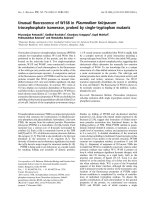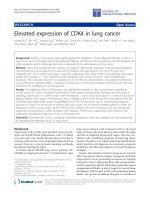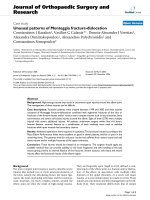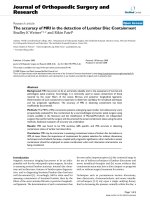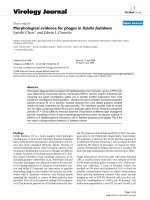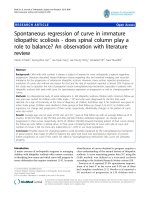Báo cáo hóa học: "Unusual source of tachycardia in an adolescent" ppt
Bạn đang xem bản rút gọn của tài liệu. Xem và tải ngay bản đầy đủ của tài liệu tại đây (2.01 MB, 4 trang )
CAS E REP O R T Open Access
Unusual source of tachycardia in an adolescent
Marvin B Mata
1
, Brian T Kloss
2*
, Jennifer A Campoli
2
, Karen Teelin
1
Abstract
Mahaim fiber tachycardia is an uncommon cause of palpitations among the pediatric population. This case report
describes an adolescent female who presented with recurrent episodes of tachycardia with chest pain and
dizziness. Her ECG showed tachycardia with wide QRS complexes and left bundle branch block pattern. Repeat
ECG after adenosine treatment revealed sinus rhythm with persistence of the left bundle branch block pattern.
Metoprolol was started however she continued to have episodes of sustained tachycardia.
Electrophysiologic study then confirmed the diagnosis of Mahaim fiber tachycardia. Treatment was successful with
mapping of the accessory pathways followed by radiofrequency ablation.
Introduction
Patients who present with wide complex tachycardia are
always challenging both diagnostically and therapeuti-
cally. There can be disagreement among physicians over
the ECG interpretation and the best treatment option
for the patient. Mahaim fiber is an uncommon cause of
tachycardia in which cardia c pre-excitation occurs via
slow-conducting, long accessory pathways that terminate
in the right ventricular free wall or into the adjacent
right bundle. It was first reported by Mahaim and
Bennett who found accessory conducting tissues that
originated from the Bundle of His and terminated in the
right ventricle. Subsequently, other investigators have
elucidated the electrophysiologic properties of this path-
way leading to the currently accepted concept of slow
and decremental anterograde fiber conduction.
Case report
A 17-year-old previously healthy female presented to the
emergency department in the early morning hours with
a feeling that her heart was racing. Her symptoms had
been ongoing for several hours with accompanying
shortness of breath, lightheadedness, nausea, and vomit-
ing. She had experienced recurrent palpitations that
usually spontaneously resolved within 20 min over the
past year. On the evening prior to presentation, she had
drunk multiple cans of caffeinated soda and was up
most of the night. She denied drug and alcohol use,
fever, recent illness, or any other significant past medical
history.
At presentation, her heart rate was 220 beats per min-
ute. The electrocardiogram (ECG) rev ealed a wide com-
plex tachycardia with left bundle branch morphology, a
superior axis, an rS in lead III, an R wave in V1, and late
QRS transition (after V5) (Figure 1). She was treated with
6 mg rapid-infusion adenosine intravenously, which
reduced her heart rate to 78 beats per minute. The repeat
ECG showed a sinus rhythm with premature ventricular
complexes and left bundle branch block morphology
(Figure 2).
Urine toxicology screen, complete blood count, com-
plete metabolic panel, thyroid function tests, and beta-
HCG laboratory work all came back within normal limits.
The patient was hospitalized for additional monitoring
and remained stable on Metoprolol. Just prior to dis-
charge she developed another episode of sustained
tachycardia of the same character, which reverted b ack
to sinus rhythm after the administrat ion of adenosine.
She was then discharged on extended release Metopro-
lol, 25 mg PO daily. A cardiac catheterization with an
electrophysiologic study was scheduled to be performed
on an outpatient basis.
Electrophysiology showed normal baseline conduction
intervals. However, on rapid atrial pacing she demon-
strated the same widened QRS complexes with left bundle
branch pattern and axis of about 0 degrees on the frontal
plane without PR shortening. Careful mapping showed tri-
ple Mahaim potentials along the right lateral tricuspid
annulus with slow conduction of the right accessory path-
ways, which resolved with the administration of adenosine.
* Correspondence:
2
Department of Emergency Medicine, SUNY Upstate Medical University,
Syracuse, NY, USA.
Full list of author information is available at the end of the article
Mata et al. International Journal of Emergency Medicine 2011, 4:9
/>© 2011 Mat a et al; licensee Springer. This is an Open Access articl e distributed under the terms of the Creative Commons Attribution
License (http://creativeco mmons.org/licenses/by/2.0), which permits unrestricted use, distribution, and reproduction in any medium,
provided the original work is properly cited.
These findings were highly suggestive of Mahaim fiber
accessory pathway and were successfully treated with
radiofrequency ablation.
Discussion
The patient described in this report is a previously
healthy adolescent who presented with recurrent epi-
sodes of tachycardia felt as palpitations with or without
chest pain and lightheadedness. Clinical presentation of
Mahai m fiber tachyca rdia varies widely and ranges from
the asymptomatic to symptomatic arrhythmias with pal-
pitations, light headedness, chest pain, syncope, and
even sudden cardiac death. Associated conditions may
include Ebstein’s anomaly, atrial septal defect, hyper-
trophic cardiomyopathy, rheumatic heart disease,
Klippel-Feil syndrome, anomalous origin of the left
main coronary artery to the right aortic sinus, partial
anomalous pulmonary venous return, Rett syndrome,
and coronary artery disease. Although there are no clini-
cal variables that highly correlate SVT with aberrancy, a
focused history and physic al examination help to rule
out other etiologies. Tachycardia coupled with the pre-
sence of cannon A waves due to AV dissociation point
to a ventricular rather than a supraventricular cause. As
in this case, an adolescent without any significant prior
medical history is more likely to have supraventricular
tachycardia; however, neither age nor gender is sensitive
or specific enough to determine the underlying etiology
of a wide complex tachycardia alone.
Normal heart conduction occurs from the sino-atrial
(SA) node in the atrium to the atrioventricular (AV)
node, and then progresses along the His Purkinje fibers
of the ventricle. Anatomically, Mahaim fibers originate
from the right atrium along the tricuspid annulus and
insert distally into the right ventricle free wall or near
the right bundle branch [1,2]. Ventricular endocardial
mapping has identified the more common forms as
atriofascicular and atrioventicular tracts [3].
When the patient was i n sinus rhythm, the ECG
revealed an rS pattern in lead III and persistent left bun-
dle branch block at slower rates, whereas a wide com-
plex QRS with left bundle branch block pattern and
superior axis was observed during tachycardia. The dif-
ferential diagnoses fo r wide complex tachycardia include
SVT with aberrancy, ventricular tachycardia, Wolff
Parkinson White Syndrome, electrolyte abnormality, and
drug toxicity, among others. However, there was no AV
dissociation noted, and the left bundle branch block
Figure 1 The electroca rdiogram (ECG) revealed a wide complex tachycardia with left bundle branch morphology, a superior axis, an
rS in lead III, an R wave in V1, and late QRS transition (after V5).
Mata et al. International Journal of Emergency Medicine 2011, 4:9
/>Page 2 of 4
pattern provided a significant clue leading to the correct
diagnosis.
Normal atrioventicular conduction usually occurs at a
slow rate, and so ECG findings in sinus rhythm may be
normal. The accessory pathways are not activated
because of their slower rate. Subtle but very important
clues to the diagnosis of Mahaim fiber include the
absence of Q wave in leads V5 or V6, or a narrow QRS
with an rS pattern in lead III during sinus rhythm with a
left axis deviation [3,4]. Other reported findings for the
atriofascicular pathway include the QRS axis between 0
and -75°, QRS width ≤ 0.15 s, an R wave in lead I, an rS
pattern in lead V
1
,RS>1QRStransition>V
4
, and cycle
length between 220 and 450 ms with 87.5% sensitivity [5].
With rapid heart rates condu ction occurs through the
accessory pathway. Most of the conduction then happens
along the accessory pathways, which depolarizes the right
ventricular myocardium first then spreads to the left. The
patient’s electrophysiology study later showed an antidro-
mic atrioventricular reentry tachycardia (AVRT) with
antegrade conduction through the accessory pathway and
retrograde conduction via the AV nodal axis. All of these
explain the more common finding of left bundle branch
block morphology with widened QRS complex during
tachycardia due t o Mahaim fiber activation as observed
in this patient. In addition, dual AV nodal pathways were
noted. This finding is present in as many as 85% of
patients with this disorder [6].
Pharmacologic response to quinidine, digoxin, propra-
nolol, and adenosine has been reported. The patient’s
response to adenosine and the development of ventri cu-
lar extrasystoles after the treatment suggest possible AV
nodal properties of the Mahaim fiber with possible
spontaneous automaticity. Adenosine is a purine nucleo-
side that acts on the adenosine 1 receptor causing a
conduction blockade at the AV node. The administra-
tion of this drug necessitates cardiac monitoring as ade-
nosine can shorten the refractory period of accessory
pathways and in Mahaim fiber tachycardia can poten-
tially precipitate atrial fibrillation.
Radiofrequency ablation remains the treatment of
choice for this disorder. Mapping the accessory fibers
identifies the proximal and distal insertion of t he fibers
to allow for successful ablation [1,7-9].
Conclusion
Mahaim fiber tachycardia is an uncommon cause of tachy-
car dia in children. ECG shows tachycardia with widened
QRS complexes and left bundle branch block pattern,
which in this case responded to ra pid intravenous
Figure 2 The repeat ECG showed a sinus rhythm with premature ventricular complexes and left bundle branch block morphology.
Mata et al. International Journal of Emergency Medicine 2011, 4:9
/>Page 3 of 4
adenosine infusion. Electrophysiologic mapping of the
fibers is the key to diagnosis and successful ablation.
This case report met t he criteria for an exem ption for
review by the Institutional Review Board for the Protec-
tion of Human Subjects at SUNY Upstate Medical
University.
Consent
This case report qualifies as for an IRB exemption from
the SUNY Upstate Medical University IRB Board given
its nature as a case report wherein no patient identifiers
are disclosed or revealed in the publication process. A
copy of the IRB exemption policy is available for review
by the Editor-in-Chief of this journal. Signed consent
from the patient was obtained.
Author details
1
Department of Pediatrics, SUNY Upstate Medical University, Syracuse, NY,
USA.
2
Department of Emergency Medicine, SUNY Upstate Medical University,
Syracuse, NY, USA.
Authors’ contributions
MM served as the first author. BK oversaw the collection and editing of the
ECG images as well as served as corresponding author. KT proof read the
paper and JC oversaw the organization of the paper.
Competing interests
The authors declare that they have no competing interests.
Received: 19 April 2010 Accepted: 16 March 2011
Published: 16 March 2011
References
1. Bohora S, Dora SK, Namboodiri N, Valaparambil A, Tharakan J:
Electrophysiology study and radiofrequency catheter ablation of
atriofascicular tracts with decremental properties (Mahaim fibre) at the
tricuspid annulus. Eurospace 2008, 10:1428-1433.
2. Morita N, Kobayashi Y, Katoh T, Takano T: Anatomic and
electrophysiologic evaluation of a right lateral atrioventricular Mahaim
fiber. Pacing & Clinical Electrophysiology 2005, 28:1138-1141.
3. Haissaguerre M, Cauchemez B, Marcus F, Le Métayer P, Lauribe P, Poquet F,
Gencel L, Clémenty J: Characteristics of the ventricular insertion sites of
accessory pathways with anterograde decremental conduction
properties. Circulation 1995, 91:1077-1085.
4. Sternick EB, Timmermans C, Sosa E, Cruz FE, Rodriguez LM, Fagundes MA,
Gerken LM, Wellens HJ: The electrocardiogram during sinus rhythm and
tachycardia in patients with Mahaim fibers: the importance of an “rS”
pattern in lead III. Journal of the American College of Cardiology 2004,
44:1626-1635.
5. Sternick EB, Cruz FES, Timmermans C, Sosa EA, Rodriguez LM, Gerken LM,
Fagundes ML, Scanavacca MI, Wellens HJ: Electrocardiogram during
tachycardia in patients with anterograde conduction over a Mahaim
fiber: old criteria revisited. Heart Rhythm 2004, 1:406-413.
6. Szumoski L, Bodalski R, Jedynak Z, Szufladowicz E, Kepski R, Derejko P,
Urbanek P, Michalak E, Orczykowski M, Zakrzewska J, Przybylski A, Walczak F:
The clinical course and risk in patients with pseudo-Mahaim fibers.
Cardiology Journal 2008, 15:365-370.
7. Silva MA, Berardi G, Kraemer A, Nadalin E, Jorge JC: Catheter ablation of
atriofascicular Mahaim fibers guided by the activation potential. Arquivos
brasileiros de cardiologia 2003, 80:61-70.
8. Okishige K, Goseki Y, Itoh A, Tsuboi N, Sasano T, Azegami K, Ohira H,
Yamashita K, Satake S, Hiejima K: New electrophysiologic features and
catheter ablation of atrioventricular and atriofascicular accessory
pathways: evidence of decremental conduction and the anatomic
structure of the Mahaim pathway. Journal of Cardiovascular
Electrophysiology 1998, 9:22-33.
9. Haghjoo M, Arya A, Emkanjoo Z, Sadr-Ameli MA: Is the activation potential
of Mahaim pathway always a fast potential? Implication for
radiofrequency catheter ablation. Eurospace 2005, 7:440-446.
doi:10.1186/1865-1380-4-9
Cite this article as: Mata et al.: Unusual source of tachycardia in an
adolescent. International Journal of Emergency Medicine 2011 4:9.
Submit your manuscript to a
journal and benefi t from:
7 Convenient online submission
7 Rigorous peer review
7 Immediate publication on acceptance
7 Open access: articles freely available online
7 High visibility within the fi eld
7 Retaining the copyright to your article
Submit your next manuscript at 7 springeropen.com
Mata et al. International Journal of Emergency Medicine 2011, 4:9
/>Page 4 of 4
